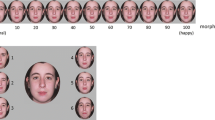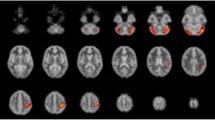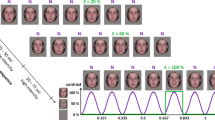Abstract
Impairments in social cognition have been frequently described in 22q11.2 deletion syndrome (22q11.2DS) and are thought to be a hallmark of difficulties in social interactions. The present study addresses aspects that are critical for everyday social cognitive functioning but have received little attention so far. Sixteen children with 22q11.2DS and 22 controls completed 1 task of facial expression recognition, 1 task of attribution of facial expressions to faceless characters involved in visually presented social interactions, and 1 task of attribution of facial expressions to characters involved in aurally presented dialogues. All three tasks have in common to involve processing of emotions. All participants also completed two tasks of attention and two tasks of visual spatial perception, and their parents completed some scales regarding behavioural problems of their children. Patients performed worse than controls in all three tasks of emotion processing, and even worse in the second and third tasks. However, they performed above chance level in all three tasks, and the results were independent of IQ, age and gender. The analysis of error patterns suggests that patients tend to coarsely categorize situations as either attractive or repulsive and also that they have difficulties in differentiating emotions that are associated with threats. An isolated association between the tasks of emotion and behaviour was found, showing that the more frequently patients with 22q11.2DS perceive happiness where there is not, the less they exhibit aggressive behaviour.



Similar content being viewed by others
References
Campbell LE, McCabe KL, Melville JL, Strutt PA, Schall U (2015) Social cognition dysfunction in adolescents with 22q11.2 deletion syndrome (velo-cardio-facial syndrome): relationship with executive functioning and social competence/functioning. J Intellect Disabil Res 59:845–859
Norkett EM, Lincoln SH, Gonzalez-Heydrich J, D’Angelo EJ (2017) Social cognitive impairment in 22q11 deletion syndrome: a review. Psychiatry Res 253:99–106
Jalbrzikowski M, Carter C, Senturk D, Chow C, Hopkins JM, Green MF et al (2012) Social cognition in 22q11.2 microdeletion syndrome: relevance to psychosis? Schizophr Res 142:99–107
Penn DL, Sanna LJ, Roberts DL (2008) Social cognition in schizophrenia: an overview. Schizophr Bull 34:408–411
Pinkham AE, Penn DL, Green MF, Buck B, Healey K, Harvey PD (2014) The social cognition psychometric evaluation study: results of the expert survey and RAND panel. Schizophr Bull 40:813–823
Campbell LE, Stevens AF, McCabe K, Cruickshank L, Morris RG, Murphy DGM et al (2011) Is theory of mind related to social dysfunction and emotional problems in 22q11.2 deletion syndrome (velo-cardio-facial syndrome)? J Neurodev Disord 3:152–161
Leleu A, Saucourt G, Rigard C, Chesnoy G, Baudouin J-Y, Rossi M et al (2016) Facial emotion perception by intensity in children and adolescents with 22q11.2 deletion syndrome. Eur Child Adolesc Psychiatry 25:297–310
Campbell L, McCabe K, Leadbeater K, Schall U, Loughland C, Rich D (2010) Visual scanning of faces in 22q11.2 deletion syndrome: attention to the mouth or the eyes? Psychiatry Res 177:211–215
Franchini M, Schaer M, Glaser B, Kott-Radecka M, Debanné M, Schneider M et al (2016) Visual processing of emotional dynamic faces in 22q11.2 deletion syndrome. J Intellect Disabil Res. https://doi.org/10.1111/jir.12250
McCabe KL, Melville JL, Rich D, Strutt PA, Cooper G, Loughland CM et al (2013) Divergent patterns of social cognition performance in autism and 22q11.2 deletion syndrome (22q11DS). J Autism Dev Disord 43:1926–1934
McCabe K, Rich D, Loughland CM, Schall U, Campbell LE (2011) Visual scanpath abnormalities in 22q11.2 deletion syndrome: is this a face specific deficit? Psychiatry Res 189:292–298
Glaser B, Debbané M, Ottet M-C, Vuilleumier P, Zesiger P, Antonarakis SE et al (2010) Eye gaze during face processing in children and adolescents with 22q11.2 deletion syndrome. J Am Acad Child Adolesc Psychiatry 49:665–674
McCabe KL, Marlin S, Cooper G, Morris R, Schall U, Murphy DG et al (2016) Visual perception and processing in children with 22q11.2 deletion syndrome: associations with social cognition measures of face identity and emotion recognition. J Neurodev Disord 8:30
Shashi V, Veerapandiyan A, Schoch K, Kwapil T, Keshavan M, Ip E et al (2011) Social skills and associated psychopathology in children with chromosome 22q11.2 deletion syndrome: implications for interventions. J Intellect Disabil Res 56:865–878
Shamay-Tsoory SG, Aharon-Peretz J (2007) Dissociable prefrontal networks for cognitive and affective theory of mind: a lesion study. Neuropsychologia 45:3054–3067
Tager-Flusberg H, Sullivan K (2000) A componential view of theory of mind: evidence from Williams syndrome. Cognition 76:59–90
Kolb B, Wilson B, Taylor L (1992) Developmental changes in the recognition and comprehension of facial expression: implications for frontal lobe function. Brain Cogn 20:74–84
Crick NR, Dodge KA (1994) A review and reformulation of social information-processing mechanisms in children's social adjustment. Psychol Bull 115:74–101
Scherer K (2003) Vocal communication of emotion: a review of research paradigms. Speech Commun 40:227–256
Mucci A, Galderisi S, Rossi A, Rocca P, Bertolino A, Bucci P et al (2016) Relationships between neurocognition, social cognition and functional outcome in schizophrenia. Eur Psychiatry Suppl 33:S67
Fett AK, Viechtbauer W, Dominguez M, Penn DL, van Os J, Krabbendam L (2011) The relationship between neurocognition and social cognition with functional outcomes in schizophrenia: a meta-analysis. Neurosci Biobehav Rev 35:573–588
Schmidt SJ, Mueller DR, Roder V (2011) Social cognition as a mediator variable between neurocognition and functional outcome in schizophrenia: empirical review and new results by structural equation modeling. Schizophr Bull 37(2):S41–S54
Badoud D, Schneider M, Menghetti S, Glaser B, Debbané M, Eliez S (2017) Understanding others: a pilot investigation of cognitive and affective facets of social cognition in patients with 22q11.2 deletion syndrome (22q11DS). J Neurodev Disord 9:35
John RJ (2003) Raven progressive matrices. In: McCallum R (ed) Handbook of nonverbal assessment. Springer US, Boston, pp 223–237
Manly T, Robertson I, Anderson V, Mimmo-Smith I (2004) TEA-Ch Test d’évaluation de l’attention chez l’enfant. ECPA, Paris
Rey A (1964) L'examen clinique en psychologie. PUF, coll. Le psychologue, Paris
Korkman M, Kirk U, Kemp S (2007) NEPSY-II: A developmental neuropsychological assessment, Second Edition. San Antonio, TX: Harcourt Assessment
Korkman M, Kirk U, Kemp S (2012) NEPSY-II Bilan neuropsychologique de l’enfant 2nde édition. ECPA, Paris
Aman M, Singh N (1994) Aberrant Behavior Checklist French (European). Questionnaire sur les comportements anormaux version pour les sujets non-institutionalisés. Slosson Educational Publication, East Aurora
Dodge KA, Coie JD (1987) Social-information-processing factors in reactive and proactive aggression in children's peer groups. J Pers Soc Psychol 53:1146–1158
Poulin F, Boivin M (2000) Reactive and proactive aggression: evidence of a two-factor model. Psychol Assess 12:115–122
Berndt DJ, Kaiser CF (1999) Manuel: Echelle composite de dépression pour enfant (MDI-C). ECPA, Paris
Brechet C (2017) Children's recognition of emotional facial expressions through photographs and drawings. J Genet Psychol 178:139–146
MacDonald PM, Kirkpatrick SW, Sullivan LA (1996) Schematic drawings of facial expressions for emotion recognition and interpretation by preschool-aged children. Genet Soc Gen Psychol Monogr 122:373–388
Ekman P, Friesen WV (1971) Constants across cultures in the face and emotion. J Pers Soc Psychol 17:124–129
Ross ED, Thompson RD, Yenkosky J (1997) Lateralization of affective prosody in brain and the callosal integration of hemispheric language functions. Brain Lang 56:27–54
Dugard P, File P, Todman J, Todman JB (2012) Single-case and small-n experimental designs: a practical guide to randomization tests. Routledge Academic, New York
Sham PC, Purcell SM (2014) Statistical power and significance testing in large-scale genetic studies. Nat Rev Genet 15:335–346
Camargo A, Azuaje F, Wang H, Zheng H (2008) Permutation-based statistical tests for multiple hypotheses. Source Code Biol Med 3:15
Steiger JH (1980) Tests for comparing elements of a correlation matrix. Psychol Bull 87:245–251
Jalbrzikowski M, Villalon-Reina JE, Karlsgodt KH, Senturk D, Chow C, Thompson PM et al (2014) Altered white matter microstructure is associated with social cognition and psychotic symptoms in 22q11.2 microdeletion syndrome. Front Behav Neurosci 8:393
Ho JS, Radoeva PD, Jalbrzikowski M, Chow C, Hopkins J, Tran W-C et al (2012) Deficits in mental state attributions in individuals with 22q11.2 deletion syndrome (Velo-Cardio-facial syndrome). Autism Res 5:407–418
Angkustsiri K, Goodlin-Jones B, Deprey L, Brahmbhatt K, Harris S, Simon TJ (2013) Social impairments in chromosome 22q11.2 deletion syndrome (22q11.2DS): autism spectrum disorder or a different endophenotype? J Autism Dev Disord 44:739–746
Chronaki G, Garner M, Hadwin JA, Thompson MJ, Chin CY, Sonuga-Barke EJ (2015) Emotion-recognition abilities and behavior problem dimensions in preschoolers: evidence for a specific role for childhood hyperactivity. Child Neuropsychol 21:25–40
Gur RE, Yi JJ, McDonald-McGinn DM, Tang SX, Calkins ME, Whinna D et al (2014) Neurocognitive development in 22q11.2 deletion syndrome: comparison with youth having developmental delay and medical comorbidities. Mol Psychiatry 19:1205–1211
Reeve J (2014) Understanding motivation and emotion, 6th edn. Wiley, Hoboken
Gray JA (1987) The psychology of fear and stress, 2nd edn. Cambridge University Press, Cambridge
Penton-Voak IS, Thomas J, Gage SH, McMurran M, McDonald S, Munafò MR (2013) Increasing recognition of happiness in ambiguous facial expressions reduces anger and aggressive behaviour. Psychol Sci 24:688–697
Acknowledgements
This study benefited from funding support from the LABEX CORTEX (ANR-11-LABX-0042) of the University of Lyon, under the “Investissements d’ Avenir” programme (ANR-11-IDEX-0007) run by the French National Research Agency (ANR). The authors are grateful to Maité Delgado for the production and adaptation of all stimuli of the three emotion tasks used in the present study. Many thanks to Margaux Vurpas for preparing and conducting the pilot study.
Author information
Authors and Affiliations
Corresponding author
Ethics declarations
Conflict of interest
The authors declare that they have no conflict of interest.
Ethical approval
The study was conducted in accordance with the Declaration of Helsinki and was approved by the local Ethics Committee (CPP Lyon-Sud Est IV, No. 15/041; ANSM, No. 2017-A00881-52; NCT03284060).
Informed consent
Informed written consent was obtained from all children and from their parents (or legal guardians).
Data repository
The data can be found at https://recherche.univ-lyon2.fr/etmeco/data/Peyroux-22q11-Data.zip.
Electronic supplementary material
Below is the link to the electronic supplementary material.
Rights and permissions
About this article
Cite this article
Peyroux, E., Babinet, MN., Cannarsa, C. et al. What do error patterns in processing facial expressions, social interaction scenes and vocal prosody tell us about the way social cognition works in children with 22q11.2DS?. Eur Child Adolesc Psychiatry 29, 299–313 (2020). https://doi.org/10.1007/s00787-019-01345-1
Received:
Accepted:
Published:
Issue Date:
DOI: https://doi.org/10.1007/s00787-019-01345-1




